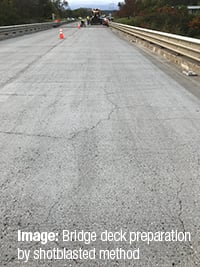Polymer additives are frequently incorporated into asphalt mix designs to improve specific...
Bridge Deck Preparation
 A thin Hot-Mix Asphalt (HMA) overlay is commonly used to protect existing and new bridge deck structures. The addition of polymer-modified additives to HMA overlays is designed to provide a protective wearing course for this structural element. The asphalt overlay will protect the bridge deck surface from water permeation, flexural fatigue, rutting and shoving. However, the asphalt mix is not considered to be a part of the composite deck slab thickness.
A thin Hot-Mix Asphalt (HMA) overlay is commonly used to protect existing and new bridge deck structures. The addition of polymer-modified additives to HMA overlays is designed to provide a protective wearing course for this structural element. The asphalt overlay will protect the bridge deck surface from water permeation, flexural fatigue, rutting and shoving. However, the asphalt mix is not considered to be a part of the composite deck slab thickness.
Bridge decks have to withstand the impact of live traffic and environmental loads on a daily basis. Over time, decks begin to deteriorate. Potholes, slippage, rutting and shoving are indications that the existing asphalt pavement is failing. An important component in any bridge deck rehabilitation project is the installation of an HMA overlay. Before the asphalt wearing or surface course can be installed, the bridge deck has to be properly prepared to receive the asphalt overlay.
Repairs to or installation of new steel should be completed prior to the start of repairs on the bridge deck. It is essential that the deck surface be properly prepared and in sound condition before the placement of the new HMA overlay.
Related article: How Rosphalt Products Helped The Tappan Zee Bridge Construction
 In the case of a steel deck, the receiving surface should be cleaned with a solvent that is compliant with local volatile organic compound regulations. Next is abrasive blast cleaning in accordance with the project-specified Steel Structures Painting Council/ National Association of Corrosion Engineers Standard. A specified primer may be applied after blast cleaning.
In the case of a steel deck, the receiving surface should be cleaned with a solvent that is compliant with local volatile organic compound regulations. Next is abrasive blast cleaning in accordance with the project-specified Steel Structures Painting Council/ National Association of Corrosion Engineers Standard. A specified primer may be applied after blast cleaning.
A concrete deck, if new, should be properly cured and then prepared in accordance with the project specification. The same is true for an existing concrete deck. All repairs should be made in accordance with project specifications prior to the installation of asphalt overlays. The proper surface preparation will ensure that the tack coat or a spray-applied waterproofing membrane will adhere to the substrate.
The application of a tac coat, which acts as a bonding agent, is necessary for the asphalt overlay to adhere to the bridge deck surface. Before the placement of the asphalt wearing course, the surface of the tack coat should be free of dust, dirt or any other surface contamination that may act as a bond breaker between the tack coat and asphalt overlay. The level of cleanliness and cleaning methods are typically called out in the project specifications.
If you have any questions or require information for your next paving project, please visit the Chase website at www.chasecorp.com/Rosphalt.







